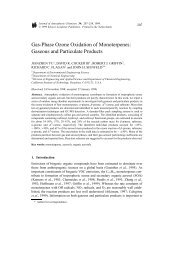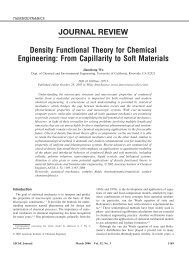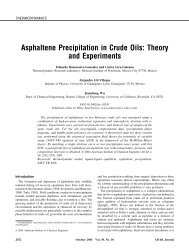DEVELOPMENT OF REVISED SAPRC AROMATICS MECHANISMS
DEVELOPMENT OF REVISED SAPRC AROMATICS MECHANISMS
DEVELOPMENT OF REVISED SAPRC AROMATICS MECHANISMS
Create successful ePaper yourself
Turn your PDF publications into a flip-book with our unique Google optimized e-Paper software.
Table 3.<br />
Rate constants assigned for the reactions of OH radicals aromatic hydrocarbons whose<br />
mechanisms were updated for this work. The estimated rate constants for the addition of<br />
OH radicals to the aromatic ring are also shown.<br />
Compound<br />
Total kOH [a]<br />
Ring Addition [b]<br />
k(300) A Ea Note [c] k(300) Fract. Note [d]<br />
Benzene 1.22e-12 2.33e-12 193 1 1.22e-12 100% 1<br />
Toluene 5.58e-12 1.81e-12 -338 1 5.18e-12 93% 2<br />
Ethyl benzene 6.50e-12 - - 2 5.11e-12 79% 3<br />
n-Propyl benzene 6.13e-12 - - 3 3.31e-12 54% 3<br />
Isopropyl benzene (cumene) 6.20e-12 - - 4 5.11e-12 82% 3<br />
o-Xylene 1.36e-11 - - 1 1.29e-11 95% 4<br />
m-Xylene 2.31e-11 2.31e-11 0 1 2.20e-11 95% 4<br />
p-Xylene 1.43e-11 1.43e-11 0 1 1.29e-11 90% 4<br />
1,2,3-Trimethyl benzene 3.27e-11 - - 1 3.13e-11 96% 3<br />
1,3,5-Trimethyl benzene 5.67e-11 - - 1 5.48e-11 97% 4<br />
1,2,4-Trimethyl benzene 3.25e-11 - - 1 3.12e-11 96% 4<br />
o-Ethyl toluene 1.19e-11 - - 1 1.00e-11 84% 3<br />
m-Ethyl toluene 1.86e-11 - - 1 1.67e-11 90% 3<br />
p-Ethyl toluene 1.18e-11 - - 1 9.94e-12 84% 3<br />
[a] Total rate constant for the reactions of the aromatic with OH radicals. Temperature dependence is<br />
given by A exp(-Ea/T), where T is the temperature in degrees K, and the units of k(300) (the rate<br />
constant at 300K) and A are cm 3 molec -1 s -1 , and Ea is the activation energy in degrees K. The notes<br />
indicate the source of the rate constant used. A “-” in the activation energy (Ea) column means that<br />
there is no information in the reference cited about the temperature dependence of the rate constant,<br />
and a “0” in that column means that there are experimental data indicating that the temperature<br />
dependence is negligible.<br />
[b] The estimated rate constant for the addition of OH radicals to the aromatic ring in cm 3 molec -1 s -1 and<br />
the fraction reacted by addition in percent. The notes column indicates how this was estimated. The<br />
rate constants or fractions reacted by abstraction from the methyl or ethyl substituent are the<br />
differences between the total rate constant or fraction and the rate constant or fraction for addition to<br />
the aromatic ring.<br />
[c] Sources for the total OH rate constants used are as follows:<br />
1 As recommended or tabulated by Atkinson and Arey (2003). Same as used in <strong>SAPRC</strong>-07 (Carter,<br />
2010a,b).<br />
2 Average of 6.03 x 10 -12 cm 3 molec -1 s -1 (Ohta and Ohyama, 1985), 6.49 x 10 -12 cm 3 molec -1 s -1<br />
(Lloyd et al., 1976; measured at ~305 K), 7.95 x 10 -12 cm 3 molec -1 s -1 (Ravishankara et al., 1978;<br />
measured at 200 torr He), 5.85 x 10 -12 cm 3 molec -1 s -1 (Anderson et al., 2003) and 6.2 x 10 -12 cm 3<br />
molec -1 s -1 (Anderson et al., 2004).<br />
3 Average of the rate constants reported by Ravishankara et al. (1978), (6.4 ± 0.36) x 10 -12 cm 3<br />
molec -1 s -1 at 20 torr He, (5.86 ± 0.16) x 10 -12 cm 3 molec -1 s -1 at 200 torr He, This is very close to<br />
6.14 x 10 -12 cm 3 molec -1 s -1 rate constant from Ohta and Ohyama (1985).<br />
16
















